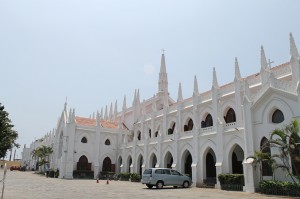
It was a hot and clear day when a friend of mine dropped me off nearby St. Thomas Basilica in Mylapore, an old district in Chennai, India.
“This is a neighborhood where you can see different houses of worship, churches, mosques and temples,” she explained.
In ancient times, Mylapore engaged in active trading with the Roman Empire. The settlement of Santhome in Mylapore was mentioned by merchants from Arab when they came to the area in the 9th and 10th centuries.
When I was entering the huge compound of the white cathedral, it was hard to believe I was in India, a country where Hinduism is the major religion and Hindu temples are ubiquitous.
In Chennai itself, Catholics make up about 5 percent of the population and the cathedral was built by the Portuguese after they arrived in the 16th century with no local influence.
The St. Thomas Basilica is the mother church of the Roman Catholic Archdiocese of Madras and Mylapore, and the complex houses some other buildings. One of the newer additions houses a museum and an underground tomb chapel. Pilgrims are allowed to pray in an underground tomb chapel without disturbing the sacred functions in the church.
There were only four other foreign tourists during my visit, while a mass was being held in Tamil.
Upstairs, a simple museum exhibits artifacts and the history of St. Thomas and the basilica, including how Christianity dispersed in India.
According to the tradition of the Christian church in Kerala on the south west coast of India, St. Thomas, one of Jesus’s apostles, arrived around 52 A.D. from Judea. He died as a martyr in 72 A.D. in the outskirts of Chennai, which is now known as St. Thomas Mount. The body of St. Thomas was buried on the spot where the basilica was later built.
In the 19th century, when the British colonized India, they rebuilt it as a church with a cathedral status.
Pope Pius XII increased the status of the cathedral into minor basilica in 1956, and it has become a popular destination for Christian Indians since. The St. Thomas Basilica in Chennai is allegedly one of the three churches in the world that was built over the tomb of the 12 apostles of Jesus.
Stained-glass windows show images of St. Thomas inside.
Back outside on Kutchery Road in the Santhome neighborhood, many of Santhome’s buildings are related to Catholicism, such as the college, pastoral center and school, I also passed a Hindu quarter with shops selling goods needed for services and ceremonies in Hindu temples.
Just a few meters across, I spotted a small Jain temple. Jainism is one of the oldest religions in the world with most of its followers hailing from India.
By the end of my temple trail in Santhome, I was almost overwhelmed by the great diversity of faith, but at the same time, it was a relief to see that people of different religions can live peacefully side by side.
source: http://www.thejakartaglobe.com / Jakarta Globe / Home> Category: Features, Travel / by Wahyuni Kamah / October 20th, 2013